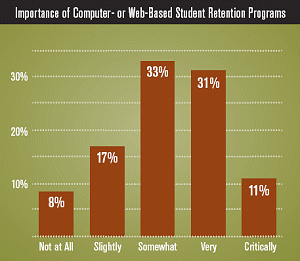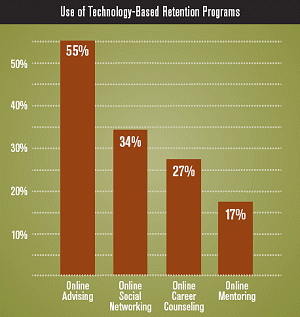Retention Rx
While most higher ed institutions consider technology-based interventionscritical to student retention, few have any kind of early warning system inplace to identify at-risk students.
The following online article, "Student Retention: AreSchools Taking Advantage of Technology?", ran on May 13, 2008.
COLLEGE AND UNIVERSITY administratorsconsider personal attention to be the most critical factor inretaining at-risk students. But what role should technologyplay in the effort? While many institutions consider technology-based interventions important to student retention,few seem to be using such solutions, and only 2 percenthave any kind of early warning system in place to identifyat-risk students, according to data released to CT byhigher education strategy firm EducationDynamics.
 The February/March 2008 survey included stats from 357 respondents from 46 states and the District of Columbia. Respondents represented a variety of higher ed institutions: 69 percent had less than 20 percent of their student body enrolled in graduate programs; 51 percent said that more than 70 percent of their student body is made up of undergraduates; 77 percent had enrollment of 10,000 or fewer students; 46 percent had fewer than 3,000 students; and 76 percent said that more than half their students depend on federal financial aid to pay for school.
The February/March 2008 survey included stats from 357 respondents from 46 states and the District of Columbia. Respondents represented a variety of higher ed institutions: 69 percent had less than 20 percent of their student body enrolled in graduate programs; 51 percent said that more than 70 percent of their student body is made up of undergraduates; 77 percent had enrollment of 10,000 or fewer students; 46 percent had fewer than 3,000 students; and 76 percent said that more than half their students depend on federal financial aid to pay for school.
Retention Strategies for At-Risk Students
 Among the findings, respondents rated in-person meetings and one-on-one phone calls as the two most effective means for engaging students at risk. Respondents were asked to rate the effectiveness of various programs on a scale of 1 to 5, with 5 being the most effective. In-person meetings rated a 4.5, and one-on-one phone calls rated a 4. Social networking and e-mail came in third and fourth, with mean scores of 3.3 and 3.1, respectively. SMS/text messaging rounded out the top five at 2.6. The bottom three methods were pre-recorded MP3 files (2), postal mail (2.2), and voicemail (2.5).
Among the findings, respondents rated in-person meetings and one-on-one phone calls as the two most effective means for engaging students at risk. Respondents were asked to rate the effectiveness of various programs on a scale of 1 to 5, with 5 being the most effective. In-person meetings rated a 4.5, and one-on-one phone calls rated a 4. Social networking and e-mail came in third and fourth, with mean scores of 3.3 and 3.1, respectively. SMS/text messaging rounded out the top five at 2.6. The bottom three methods were pre-recorded MP3 files (2), postal mail (2.2), and voicemail (2.5).
When asked about the importance of computer- or web-based programs aimed at reducing attrition and improving retention, most (64 percent) said such programs were "somewhat" or "very" important (see first chart).
However, only a little more than half of respondents (55 percent) reported that their institutions offer online advising services, and only about a third or less reported using either online social networking, online career counseling, or online mentoring (see second chart).

